A Salad Table...Fresh Salads Footsteps
Away from Your Kitchen!
A Salad Table, also called a Salad Bench, is a great way to grow lettuces, spinach, Asian greens, scallions, and other shallow-rooted vegetables on your deck or apartment balcony.
|
©Steve Masley…Click IMAGE to Enlarge |
It’s basically a long, narrow 2x4 (38x89mm) frame with a wire mesh bottom, usually ½” (13mm) hardware cloth.
In the simplest designs, a piece of window screen cut to fit inside the frame rests on top of the hardware cloth, and keeps the potting mix from washing out. Wooden cross-pieces can be used to divide the frame into compartments to separate different vegetables or salads at varying stages of growth.
The best designs employ modular Salad Trays, discussed below.
Advantages
|
Potting Soil
|
Salad Trays
Care and Feeding of Your Salad Table
I had been growing lettuce, spinach, Asian greens, and basil in window boxes for several years when I stumbled on Anne Raver’s piece on salad benches—It Takes a Hammer to Grow this Salad —in the New York Times.
—in the New York Times.
As a deep digger and fan of raised garden beds, I knew most garden vegetables are more vigorous if they have a deep root zone. At first, I had trouble wrapping my mind around growing salads in 4” (10cm) of soil, but after I tried it, I was sold.
Salad Tables Have Many Advantages
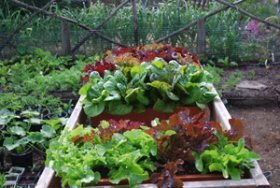
|
|
©Steve Masley…Click IMAGE to Enlarge |
They’re Mobile. In most areas of the country, lettuces—especially lettuces grown in salad trays—can’t take the hot summer sun, but they can be grown in full shade.
A mobile table lets you roll it into the shade in the summer, then roll it back out to full sun in spring and fall.
They obey the First Law of Fogey Ergonomics: Don’t bend or stoop if you don’t have to.
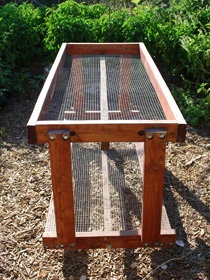
|
|
©Steve Masley Click IMAGE to Enlarge |
The plants are at waist height—you can harvest leaves, mix soils, and plant seedlings without bending over. Everything is accomplished with small movements of the waist, within the natural reach of the arms.
They get the plants up out of the shade of balcony railings. This can make a big difference in the growth of small seedlings, especially in the spring and fall, when the sun slants in at a lower angle.
They can double as a potting bench, as long as you’re using the modular salad tray system. With the trays removed, the table becomes a perfect potting bench.
Twofers are important on apartment balconies and other small space gardens, where every square inch counts.
I adapted my salad table from a design by Jon Traunfeld, a regional specialist for the University of Maryland Cooperative Extension, and a prominent advocate of salad benches.
In Traunfeld’s plans the salad table had static legs, and no bottom shelf—easier to build, but harder to move, and not as versatile as a table on wheels.
the salad table had static legs, and no bottom shelf—easier to build, but harder to move, and not as versatile as a table on wheels.
I modified his design, adding a second salad frame below and connecting it to the top one with 2x4” (38x89mm) legs attached with lag bolts. I put 4” (10cm) wheels on the bottom tray, so the whole thing could be moved easily, even loaded with salad trays.
In my design, the bottom shelf can be used for recently transplanted or regenerating saladscapes, or salad trays can be rotated from the top to the bottom shelf. Or it can be used for storing pots, potting mixes, or soil amendments.
Advantages | Potting Soil | Salad Trays | Care
Potting Soil
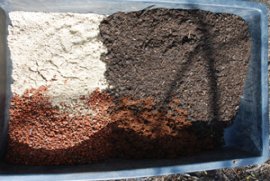
|
|
Compost, Rehydrated Coir, and Small Lava Rock ©Steve Masley...Click IMAGE to Enlarge |
Plant roots need air as well as water. Garden soils with clay and silt particles are heavy, and they’re too dense to drain properly in the shallow root zone of a salad tray or table, so “Soil-less” mixes are used in salad trays for salad benches.
A Soil-less Mix is a potting mix composed of
- a Coarse Material for drainage, like perlite, or 5/16” (8mm) horticultural lava rock
- a Nutritional Material, like garden compost, worm castings, or composted manure, to feed and support your vegetables, and a
- Water-Retaining Material like coir (coconut husk fiber), peat moss, or vermiculite, to hold moisture between waterings.
Use equal proportions if you’re using a rich nutritional component like worm castings or composted manure. If you’re using garden compost, use 1 part coarse material, 1 part water-retaining material, and 2 parts compost.
I like to use worm castings, because the last chamber of the worm gut is loaded with beneficial bacteria and fungi, and the castings are inoculated with these beneficial soil organisms as they pass through.
Most of these organisms are dormant in dried, bagged worm castings, but some revive once they’re watered.
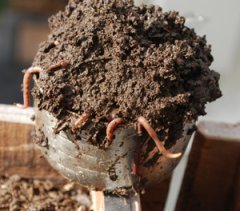
|
|
Red Compost Worms © Steve Masley…Click IMAGE to Enlarge |
Fresh worm castings—if you can get them—inevitably have a few worms and worm cocoons, as well as other compost critters like enchytreids, (a.k.a ‘potworms’, cousins of red compost worms), springtails, and orabitid turtle mites, so each tray has its own natural soil ecosystem going. For information on setting up a worm composting system, click Here.
Fresh worm castings put the nutrient cycling (self-fertilizing) capacity of a forest floor ecosystem to work in your salad trays.
The worms—and the ecosystem they bring to the tray—help convert the nutrients in the potting mix into plant-available form.
If you want to make your own potting soil, click here for a basic potting soil recipe.
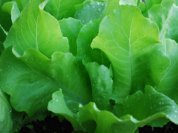
|
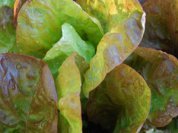
|
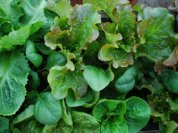
|
Advantages | Potting Soil | Salad Trays | Care
Salad Trays
Both designs use modular wooden trays that can be moved in and out of the table. They’re basically a rectangular frame made out of 1 x 4” (19x89mm) pine, with ¼” (7mm) or ½” (13mm) hardware cloth stapled to the bottom. I screw cheap drawer pulls into the top on each end, so it’s easier to move them on and off the salad bench.
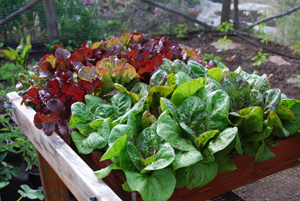
|
|
in a Salad Tray © Steve Masley…Click IMAGE to Enlarge |
My salad trays are 22” x 15” (55 x 38cm). I started with larger frames, but they were too heavy to move easily—especially when wet—so I went to smaller salad trays, and more of them.
Each holds 11 lettuce or spinach plants—two rows of 4 plants along the outside edges, with 1 row of 3 plants on staggered centers in the middle.
1 x 4” (19x89mm) pine is relatively cheap, but urban foragers may want to make salad trays from scavenged wooden pallets. Look for pallets with thicker, sturdier slats, and use a small crowbar to carefully pry the slats from the frames.
Advantages | Potting Soil | Salad Trays | Care
Care and Feeding of Salad
Benches and SaladScapes
Fertilizing
I like to build organic fertilizers into the potting mix as I’m mixing it. In the cooler weather of late fall and early spring, nutrient cycling is slower, so animal-based organic fertilizers like worm castings, composted poultry manure, blood meal, fish meal, feather meal, or bat guano work best.
From late spring through early fall, plant-based organic nitrogen sources like alfalfa meal or soy meal, work well for growing leafy greens in a salad bench.
Application rates for salad trays are 3-4 cups/tray for worm castings (omit if you used worm castings as a third of the potting soil mix) 1 cup composted chicken manure, ½ cup fish meal, blood meal, or feather meal, or 1/3 cup bat guano. (These amounts apply to my salad trays, which hold five 1-gallon (15cm) nursery pots of potting soil each.)
If you use any of these concentrated soil amendments, fill the tray halfway with potting mix, lay the amendment down in a layer over the tray, and mix it in with a cultivator or your hands. Then top off the tray with potting mix, and plant.
That way, in the unlikely event that nasty bacteria are present, they’re buried in potting mix, where they can’t splash up onto leaves when you water.
And if your guests find out the luxuriousness of the salad they’re eating comes from bat guano, you can tell them about this protocol.
Liquid organic soil amendments like fish emulsion, compost extract, and compost or manure tea work well in both cold and warm weather, but have to be applied more frequently. I usually use them after I cut a cut-and-come-again salad tray, to speed regeneration.
Use overhead watering to apply them, then spray the leaves with a gentle “shower” setting to wash the fertilizer off the foliage and into the soil.
Avoid applying liquid fertilizers within 2 weeks of harvesting. This gives UV time to kill off any stray pernicious bacteria on the leaves.
Watering
Salad benches and salad trays have one big drawback: they need frequent watering. Three or four trays will need a gallon of water a day—more, in hot weather. Drip irrigation systems can simplify this chore, but most green, leafy vegetables prefer overhead watering, so microsprinklers or overhead watering with a soft spray wand are preferable.
I’ve used 3 for overhead watering in the last 25 years. They get heavy use in our year-round growing season.
They’ll last 10-15 years if they don’t get stepped on, and if you don’t drag the hose by the handle of the wand. (There’s a plastic lip in the connector that wears out if you drag it by the handle, so grab the end of the hose and drag from there instead).
Advantages
|
Potting Soil
|
Salad Trays
Care and Feeding of Your Salad Bench
Copyright © 2009-2025, by Steve Masley, Grow-it-Organically.com
All rights reserved
HOME | About Us | Contact Us | Privacy
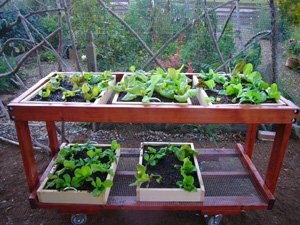

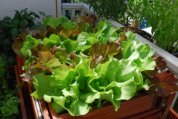
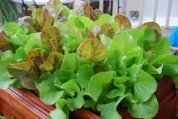
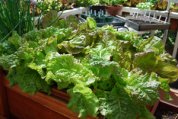
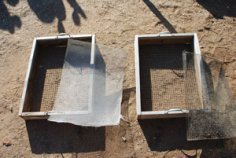
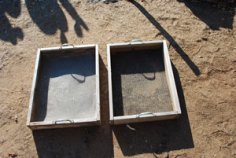
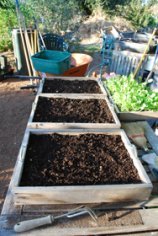
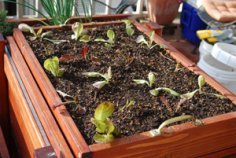
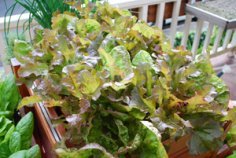
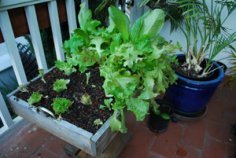
New! Comments
Have a question or comment about what you just read? Leave me a comment in the box below.